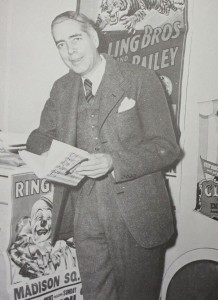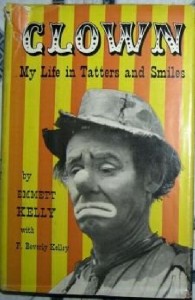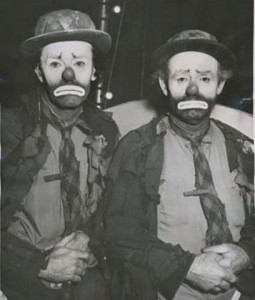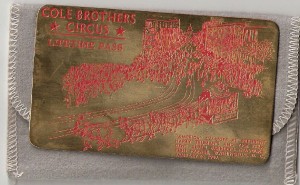Rare or one-of-a-kind circus items can present a bit of a dilemma to a collector. Should they be in a private collection, where only a few can see them, or should they be in a museum or library, available to researchers? That’s a problem I faced when a group of F. Beverly Kelley documents were offered to me.
A friend, who is an antique dealer, had come across a collection, which included several letters from the famous clown Emmett Kelly (no relation to F. Beverly Kelley). My friend correctly recognized the significance of the Emmett Kelly letters, but wasn’t sure about the others. She didn’t know that F. Beverly Kelley is just as important to circus collectors as Emmett Kelly.

Billboard called Bev Kelley “erudite” and “master of punchy adjectives.” He held various positions with Ringling Bros. and Barnum & Bailey Circus over a period of 15 years.
F. Beverly (Bev) Kelley was well known in the circus world as a top publicist from 1930 until 1955. He did PR work for major circuses—Ringling Bros. and Barnum & Bailey, Hagenbeck Wallace (owned by Ringling), Dailey Bros. and Cole Bros. In his later years, he fronted many traveling Broadway shows including “Call Me Madam,” “Music Man,” “Fiddler on the Roof,” “Cabaret,” “Holy Dolly” and “My Fair Lady.”
The entire collection my friend found included more than 30 letters written to Bev Kelley, along with several circus photos and postcards. The 11 Emmett Kelly documents were particularly significant because the main subject was Emmett’s biography, “Clown, My Life in Tatters and Smiles,” written by Bev Kelley.
“Clown” was published by Prentice-Hall in 1954. The letters span the time from 1952, when the book was first being discussed, until after its publication. They were written on the road with a couple actually mailed from Havana, Cuba, when Ringling Bros. and Barnum & Bailey performed there in the winters of 1952-53 and 1953-54.

Copies of Emmett Kelly’s biography, “Clown, My Life in Tatters and Smiles,” can be found on the internet for $25 and up. Some less expensive copies are available, but they are usually ex-library editions.
Fascinating insights into the process of producing the book are revealed. In his first letter, Emmett expressed his feelings about an author for his book: “Dear Friend Bev, Thanks for your letter and interest shown in the writing of my book — biog, that is a load off my mind as I was beginning to be concerned regarding the writer . . . There are so many writers that might silly it up Pagliacci style that ruin it. I know only too well what you can do with it . . . you know the circus and are well acquainted with my style of clowning, pathos and wistfulness.”
In November 1953, Emmett wrote from the Hollywood-Roosevelt Hotel in California: “. . . I have ten titles suggested by a big writer on the coast. I have his name here someplace. I am not too happy about the I Never Was Broke,(title) as maybe it will sound too cocky in lieu of the sad puss . . .”
The next month, back at his home in Sarasota, Emmett commented on the chosen title: “Bev, it’s all in your hands, the book, and I am satisfied. Stearns (Prentice-Hall Editor) says title is Clown, My Life In Tatters and Smiles . . . sounds good other than I never smile. What do you think?”
Emmett Kelly was mostly interested in the progress of his book, but other information in the letters was about circus business in general with mentions of John Ringling North. Two years before Ringling stopped performing under the Big Top (1956), Emmett seemed to know what was coming. In a letter from Cuba dated January 1954 he wrote: “. . . after this season I think I should try my damndest to hit somewhere in TV as circuses, tenting . . . seems to be getting rough in lieu of all the changes . . . don’t look like it is as profitable a biz, as we knew it years ago and the ax may fall on us too, keep this under your Stetson Bev, but I shall keep my eyes open for a TV connection.”
PR appearances were the topic of later letters. It was a way to let the public know about the book. There were talks of appearances on Ed Sullivan and “The Jack Paar Show.” CBS Television’s “General Electric Theatre” aired Emmett’s autobiography in 1955 with Henry Fonda playing the part of Emmett. It was a half-hour version of the “Clown” book. In one letter Emmett wrote his thoughts about the special: “We got a damn good likeness on Fonda and took a gob of twin shots for Life, Look and AP.”

Emmett Kelly (right) and Henry Fonda posed for photos to promote the GE Theatre special. This photo was not part of the collection, but a copy of it sold last year on eBay for $100.
Besides the Emmett Kelly letters, the collection also included two letters to Bev Kelley from Merle Evans, longtime music director for the Ringling Bros. and Barnum & Bailey Circus band. Evans’s letters had information about the circus’s 1941 opening in Madison Square Garden and the circus band’s appearance on the Fitch Bandwagon radio program. Merle also mentioned union scale for musicians. Remember, this was 1941. He said in St. Petersburg, Fla., the pay for union musicians was $3 per half-hour.
Two other circus letters in the collection were from Henry Ringling North, both on Ringling Bros. and Barnum & Bailey letterhead. Henry Ringling North was Vice President of the circus and nephew of the Ringling Brothers.
The other documents in the collection were not from circus personnel, but many were circus related.
• One letter from Gov. Thomas J. Herbert, State of Ohio, Nov. 8, 1948—thanks for sending photos of Delaware County Fair.
• One copy of a letter from Bev. Kelley to Robert A. Taft, United States Senator from Ohio, April 19, 1949—mentions retirement from Ringling and current position with Cole Bros. Circus.
• Three letters from Sen. Taft, April 21, 1949, May 27, 1949 and June 23, 1949 — thanks for a brass replica of lifetime pass to Cole Bros. Circus and the May 27 letter has details about Taft’s re-election campaign for 1950.
• One letter from U.S. Sen. John W. Bricker (Ohio) — thanks for pass to Cole Bros. Circus.
• Two letters from Ohio Gov. Frank J. Lausche, May 22, 1949 and June 20, 1949 — The first letter is thanks for a season pass to Cole Bros. Circus. Second letter is also a thank you for circus pass and mentions the “intriguing design of the metallic pass which was given to President Truman as an incident of his inauguration.”
• A brass, lifetime pass to Cole Bros. Circus, Brass pass (mentioned above), was a promotional item Bev Kelley created to hand out to the media. Bev had managed to crash President Truman’s 1949 inaugural by planting a Cole Bros. steam calliope in the parade.

Text on the pass reads “America Calliope at President Harry Truman and Vice President Alben W. Barkley’s Inaugural Parade, Washington, D.C. January 20, 1949.”
• Three letters from Lowell Thomas — April 6, 1939, April 15, 1942 and October 17, 1944 —a thank you for tickets and congratulations for Bev’s promotion (1944)
• One letter from Gene Autry, December 30, 1948 — Gene Autry appearing with Cole Bros. Circus (also copy of reply Bev sent to Gene about partnering with Cole Bros. Circus).
• One letter from Albert Johnson (Producer, Author & Designer of American Jubilee; also worked with Ringling Bros. and Barnum & Bailey) July 28, 1949 — a hand written letter about troubles with traveling show.
• One letter from Basil O’Connor, chairman American Red Cross, August 21, 1944 — a thank you and mention of job as chairman of Red Cross during wartime being a “heavy one.”
• One letter from Basil O’Connor, president National Foundation of Infantile Paralysis, February 5, 1945 — a thank you.
• One letter from Frank Stanton, vice president of Columbia Broadcasting System (CBS), October, 20, 1944 — congratulations on Bev’s new and increased responsibilities.
• One letter from Paul Whitman, director of music for the Blue Network (NBC), April 26, 1945 — a thank you for tickets to the circus and mention of song Wabash Blues
• One letter from Curtis Baxter, Marshall College, September 12, 1950 — some details about traveling show, “Lost in the Stars,” and rooming requirements for colored members.
• One letter from John Antonello Agency, Kansas City, Missouri — August 28, 1950 — hotel arrangements for members of traveling show, “Lost in the Stars” and separate rooming requirements for colored members.
• One letter from Sam Houston — handwritten two-page letter with letterhead simply “El Paso, Texas,” dated Wednesday, 29th with no month or year — mentions meeting John Ringling North when the show played El Paso, a one day stand with very poor attendance.
• One letter from James C. Petrillo, American Federation of Musicians, to Merle Evans — February1, 1941 — about union rates for commercial broadcasting.
Here I was, given the opportunity to purchase this collection and I’ll admit, it was tempting. I could keep the circus letters and sell the others. Breaking up the lot would no doubt result in a profit. However, it was my feeling that a grouping like this should stay together and shouldn’t be hidden away in a private collection. So, I took the items to my contacts at the Ringling Circus Museum in Sarasota and we made arrangements for them to purchase the entire collection for $800.
For more information about the museum’s historic archives see my recent Worthpoint article, Tibbals Learning Center Expansion a Boon for Circus Researchers, Scholars, Historians.
Larry Kellogg is a Worthologist specializing in circus memorabilia.
———————————
WorthPoint—Discover Your Hidden Wealth